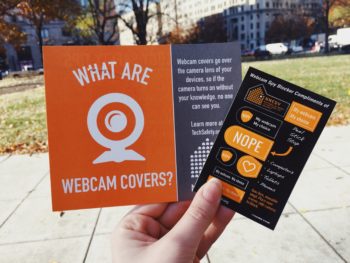How Webcams and Technology Privacy Impact Survivors
January 2, 2018
Mobile device and computer use is part of our everyday lives – from online banking, staying connected with family and friends through social media, searching for new jobs or shopping, one-fifth of Americans report going online “almost constantly” [1]. While technology can be a great help to survivors, it also can create significant privacy issues because perpetrators often abuse victims online and through devices. In a 2014 study, 97% of surveyed domestic violence programs indicated that victims who sought their services were harassed, monitored, and threatened by offenders misusing technology [2].
One way perpetrators misuse technology to stalk, monitor, and harass victims is by using spyware. Spyware refers to programs or devices that enable unauthorized persons to secretly monitor and gather information about others. A perpetrator may use spyware to invade a victim’s privacy by hacking the webcam on their device. Photos and videos taken from a webcam can be used for blackmail or harassment, and location-revealing information, such as a street sign in the background, may be used to track the victim. There is, unfortunately, no easy way to determine if spyware has been installed. Fortunately, there are steps that can be taken reduce risks and increase safety when using technological devices.

What are webcam covers? They’re effective to prevent abusers from spying on victims.
Webcam covers are an effective means to prevent abusers from spying on victims because they block access to the webcam even if it has been hacked. Webcam covers are both easy to use and accessible – most are stick-on, clip-on, or slide-on – and one can easily create their own webcam cover using opaque tape or a sticky note to cover the camera. However, webcam covers are not a defense against all tech-related threats. Even with the camera blocked, abusers who have installed spyware may still be able to hear audio through the device’s microphone or use spyware to track and harass. For example, some spyware can send electronic reports of a victim’s device activity to the perpetrator, or expose passwords and PIN numbers. Fortunately, there are many ways to maintain safety and privacy on devices. A few tips are mentioned below (for more detailed information, check out Safety Net’s Survivor Toolkit):
- Computer setup: If possible, set up your computer in a way that makes it difficult to download anything without administrator access. Protect your computer from spyware by using anti-virus and anti-spyware software and ensuring that there is proper firewall protection.
- Information safety: Save important documents onto external devices, such as USB drives, rather than the computer’s internal hard drive. This way, information is accessible only to the owner of the storage device, and not to anyone who can access the computer. Disconnecting a personal computer from a computer network and turning off file sharing can also lessen the risk of hacking.
- Safe devices: If a computer potentially has spyware installed, keep in mind that all activity may be recorded. Use a different computer, such as one at the local library or at a trusted friend’s house, or buy a new one. Be careful when transferring files from one computer to another, as spyware may be copied from an infected computer to a new one.
- Safe accounts: If an abuser has, or potentially has, access to online accounts (i.e., email, Facebook, etc.), consider creating new accounts and changing passwords on a safe computer. Use non-identifying name and account information to reduce the chance of an abuser gaining access to the new account
For more information on technology safety and stalking, visit TechSafety.org and the Stalking Resource Center.
[1] Pew Research Center, “One-fifth of Americans report going online ‘almost constantly,’” December 8, 2015. http://www.pewresearch.org/fact-tank/2015/12/08/one-fifth-of-americans-report-going-online-almost-constantly/
[2] NNEDV, “A Glimpse From the Field: How Abusers Are Misusing Technology,” 2014. https://static1.squarespace.com/static/51dc541ce4b03ebab8c5c88c/t/54e3d1b6e4b08500fcb455a0/1424216502058/NNEDV_Glimpse+From+the+Field+-+2014.pdf





